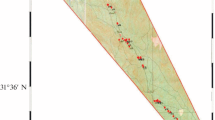Abstract
The average concentrations of Al, Si, Fe, Mn, Pb, Ni, V, Ba, and other elements were 1.5–3.5 times lower (in some cases, up to 60 times) in the macropores than in the micropores. The regularities found agreed with the rules of selective absorption of ions and their capability for the formation of complexes with the components of the soil solids. The behavior of Fe and Mn can be explained by the differences in the redox conditions in the pores of different sizes. The degree of the relationships between the soil solution and the solid phase of the matrix in the macro- and micropores differed by several orders of magnitude (within a pF range up to 4). This fact determined the different mobilization of the elements in the solutions of the macro- and micropores. The reserves of the elements were proportional not only to their concentrations but also to the amount of solution in the appropriate pores.
Similar content being viewed by others
References
A. F. Vadyunina, E. V. Shein, A. V. Kirichenko, et al., “Electrical Conductivity of Water-Unsaturated Soils and Pore Solutions,” Vestn. Mosk. Gos. Univ., Ser. 17: Pochvoved., No. 2, 42–49 (1984).
N. V. Verkhovtseva, E. Yu. Milanovskii, E. V. Shein, and Z. N. Tyugai, “Distribution of Microorganisms and Humic Substances by Particle-Size and Aggregate-Size Fractions in Chernozem,” in Materials of the IV Congr. of the Dokuchaev Soil Sci. Soc. (Nauka-Tsentr, Novosibirsk, 2004), Vol. 1, pp. 30–32 [in Russian].
R. Garrels and Ch. Christ, Solutions, Minerals, and Equilibria (Harper and Row, New York, 1965).
A. M. Globus, Experimental Hydrophysics of Soils (Gidrometeoizdat, Leningrad, 1969), 355 pp. [in Russian].
N. I. Gorbunov and I. G. Tsyurupa, “On the Problem of Uneven Concentrations of Solutions Separated from Clay Minerals and Soils,” Pochvovedenie, No. 3, 166–171 (1947).
R. I. Zaitseva, N. G. Minashina, and I. I. Sudnitsyn, “Changes in the Composition and Concentration of Sodium Sulfate Solutions in Voids,” Pochvovedenie, No. 7, 833–838 (1996) [Eur. Soil Sci. 29 (7), 770–774 (1996)].
R. I. Zaitseva, N. G. Minashina, and I. I. Sudnitsyn, “Concentration of Sodium Chloride Solutions in Pores of Various Size,” Pochvovedenie, No. 3, 330–335 (1997) [Eur. Soil Sci. 30 (3), 284–289 (1997)].
V. A. Korolev, “Bound Water in Rocks: New Facts and Problems,” Soros Obrazov. Zh. No. 9, 79–85 (1996).
S. A. Nikolaeva, E. V. Shein, E. N. Esafova, and Yu. A. Matroshilov, “Chemical Analysis of Different Fractions of Soil Solution in an Irrigated Southern Chernozem,” Vestn. Mosk. Univ., Ser. 17: Pochvoved., No. 1, 50–55 (1982).
T. K. Platonova and L. N. Shmyglaya, “Differential Porosity and Fractional Composition of Pore Solutions in Dark Chestnut Soils of the Low Syrt Plain,” Pochvovedenie, No. 6, 98–102 (1986).
Field and Laboratory Methods for Studying Soil Physical Properties and Soil Regimes. Methodological Guidelines, E. V. Shein (Ed.) (Izd-vo Mosk. Gos. Univ., Moscow, 2001), 200 pp. [in Russian].
E. M. Samoilova and V. A. Demkin, “About the Composition of Different Fractions of Soil Solutions,” Pochvovedenie, No. 11, 24–27 (1976).
A. V. Smagin and N. V. Sadovnikova, Mizuri Maauia Ben Ali, “The Determination of the Primary Hydrophysical Function of Soil by the Centrifuge Method,” Pochvovedenie, No. 11, 1362–1370 (1998) [Eur. Soil Sci. 31 (11), 1237–1244 (1998)].
V. V. Snakin, A. A. Prisyazhnaya, and O. V. Rukhovich, Composition of the Liquid Phase of Soil (REFIA, Moscow, 1997), 325 pp. [in Russian].
E. A. Timofeeva, E. I. Karavanova, and A. V. Smagin, “The Main Hydrophysical Function of Soil and the Composition of Soil Solutions in Some Soils of the Central Forest State Biospheric Nature Reserve,” Vestn. Mosk. Univ., Ser. 17: Pochvoved., No. 4, 25–30 (2007).
A. V. Trofimov, “On the Study of Nonextractable Part of Soil Solution. Negative Adsorption by Soil,” NAZh, No. 10, 613–628 (1925).
A. V. Trofimov, “The pH Value as a Function of the Content and Concentration of Soil Solution,” Pochvovedenie, No. 2, 5–43 (1931).
M. M. Umarov, A. V. Kurakov, and A. L. Stepanov, Microbiological Transformation of Nitrogen in Soil (Geos, Moscow, 2007), 138 pp. [in Russian].
E. V. Shein, A Course on Soil Physics (Izd-vo Mosk. Gos. Univ., Moscow, 2005), 432 pp. [in Russian].
M. D. Bonito, Trace Elements in Soil Pore Water: A Comparison of Sampling Methods. Theses PhD (University of Nottingham, England, 2005), 298 pp.
C. Chenu, J. Hassink, and J. Bloem, “Short-Term Changes in the Spatial Distribution of Microorganisms in Soil Aggregates as Affected by Glucose Addition,” Biol. Fertil. Soils 34, 349–356 (2001).
P. M. Jardine, G. V. Wilson, and R. J. Luxmoore, “Unsaturated Solute Transport Through a Forest Soil during Rain Storm Events,” Geoderma 46, 103–118 (1990).
J. Kinyangi, D. Solomon, B. Liang, et al., “Nanoscale Biogeocomplexity of the Organomineral Assemblage in Soil. Application of STXM Microscopy and C 1s-NEXAFS Spectroscopy,” Soil Sci. Soc. Am. J. 70, 1708–1718 (2006).
R. Marques, J. Ranger, D. Gelhaye, et al., “Comparison of Chemical Composition of Soil Solutions Collected by Zero-Tension Plate Lysimeters with those from Ceramic-Cup Lysimeters in a Forest Soil,” Eur. J. Soil Sci. 47, 407–417 (1996).
D. Santos, A. J. M. Smucker, S. L. Murphy, et al., “Uniform Separation of Concentric Surface Layers from Soil Aggregates,” Soil Sci. Soc. Am. J. 6, 720–724 (1997).
Soil Organic Matter Dynamics and Sustainability of Tropical Agriculture. Proc. of a Meeting in Leuven, Belgium, Nov. 4–6, 1991 (John Wiley & Sons, N.Y., 1991) p. 39–45.
W. De Vries, G. J. Reinds, and H. D. Deelstra, Intensive Monitoring of Forest Ecosystems in Europe. Technical Report (1999), 160 pp.
D. Zabowski and F. C. Ugolini, “Lysimeter and Centrifuge Soil Solutions: Seasonal Differences between Methods,” Soil Sci. Soc. Am. J. 54, 1130–1135 (1990).
Author information
Authors and Affiliations
Additional information
Original Russian Text © E.I. Karavanova, E.A. Timofeeva, 2009, published in Pochvovedenie, 2009, No. 12, pp. 1456–1463.
Rights and permissions
About this article
Cite this article
Karavanova, E.I., Timofeeva, E.A. Chemical composition of solutions in macro- and micropores in the upper horizons of soils in the Central Forest State Biosphere Reserve. Eurasian Soil Sc. 42, 1357–1363 (2009). https://doi.org/10.1134/S1064229309120059
Received:
Published:
Issue Date:
DOI: https://doi.org/10.1134/S1064229309120059



